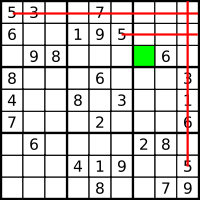Scanning
Scanning is performed at the outset and throughout the solution. Scans need to be performed only once in between analyses. Scanning consists of two techniques:
Cross-hatching: the scanning of rows to identify which line in a region may contain a certain numeral by a process of elimination. The process is repeated with the columns. For fastest results, the numerals are scanned in order of their frequency, from high to low. It is important to perform this process systematically, checking all of the digits 1–9.
Counting 1–9 in regions, rows, and columns to identify missing numerals. Counting based upon the last numeral discovered may speed up the search. It also can be the case, particularly in tougher puzzles, that the best way to ascertain the value of a cell is to count in reverse—that is, by scanning the cell's region, row, and column for values it cannot be, in order to see what remains.
Advanced solvers look for "contingencies" while scanning, narrowing a numeral's location within a row, column, or region to two or three cells. When those cells lie within the same row and region, they can be used for elimination during cross-hatching and counting. Puzzles solved by scanning alone without requiring the detection of contingencies are classified as "easy"; more difficult puzzles cannot be solved by basic scanning alone. scanning, marking up, and analyzing.

The top right region must contain a 5. By hatching across and up from 5s elsewhere, the solver can eliminate all the empty cells in the region which cannot contain a 5. This leaves only one possibility (shaded green).
Go To : Sudoku solving techniques
No comments:
Post a Comment